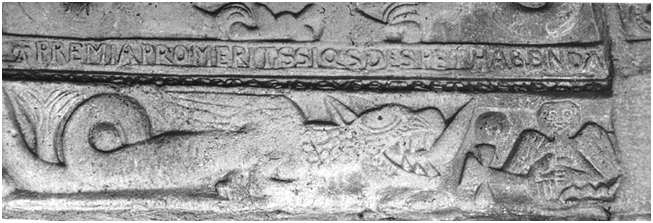
Interpreting 12th-century sculpture in English churches





Carvings at Dinton parish church
The church of SS Peter and Paul at Dinton is unusual in conserving a complete Anglo-Norman doorway from the last quarter of the 12th century, together with the lintel and the tympanum.
The carvings on the lintel
Pevsner (with many others) assumes the imagery represents St Michael and the Dragon. Webb has identified the Winged and Laughing Christ, himself the bait, confronting Leviathan with the butt of his Cross. The figure of Leviathan is closely paralleled in the illustration from Hortus Deliciarum.


Detail of the lintel at Dinton:
the smiling Christ and the wriggling worm.
Note the "apple" above the Cross.
The Latin inscription above the lintel translates: “If anyone should despair of obtaining the rewards of his deserts let him attend to the precepts and keep them in mind”. Webb (p36) speculates that the inscription may draw upon a passage in the last book of Moralia. References to ‘rewards’, ‘deserts’, ‘precepts’ and ‘despair’ may be found in preceding chapters of Moralia.
Above the head of the Cross is placed a spherical object, identified by Webb as an apple, the bait by which the Devil lured Adam and Eve to their fall.
Though hard to believe, the figure of the winged Christ appears to be laughing. He holds in his hand a wriggling worm such as those used as bait by fishermen. The sculptor shows Leviathan (Death) being mocked in his turn by the laughing Christ, who thrusts his Cross into the jaws of the monster.
Nor let any consider it unbecoming that the Incarnate Lord can be typified by such an animal [...] As it is written, “But I am a worm, and no man.” Gregory op.cit. XXX, 66
Gregory’s reference is to Psalm 22: “But I am a worm, and no man; a reproach of men, and despised of the people.” (Psalms 22:6)
The image of the worm is used to contrast the suffering of Jesus at the crucifixion with God’s divine mockery of the Devil. The same comparison was made by Ailred, Abbot of Rievaulx (1110-1167) in a sermon which was later copied in a number of manuscripts of the late 12th and early 13th centuries. The worm was taken to be prophetic of the events and sufferings of Christ.
Where O Death, has your fighting brought you? Where, O Jews, is now your mockery? O Satan, where is your astuteness? For now you yourself are being laughed at; your cunning has been detected and your malice overcome. For behold, death devours the flesh and is caught by the Strong; he pounces on the little red worm (vermiculus) and is caught on the hook. And so he is caught on the three-fold cord, when the Wisdom of God circumvents his astuteness, and His strength overcomes the Devil, and His mildness defeats his wickedness. For it was with these three evils that the cunning Enemy deceived our first parents.
Vermiculus is a generic term for a small worm or worm-like insect larva. The small red manure worm is a favoured bait of freshwater fishermen, for its blood-red colour and energetic wriggling are most likely to attract fish.
The carvings on the tympanum
At the foot of both trees can be seen three small circles. Gregory wrote: “God who is Trinity raised up the extinct flesh of the only begotten Son and it brought forth foliage as when it was first planted.” The circles at the foot of the Dinton tree look somewhat damaged!

The tympanum at Dinton shows the Life Tree of the carnally-minded man.
Pitsford’s upright Life Tree of the Righteous Man will sprout again. The notion relates to a common statement of early theologians, repeated by Gregory: “The Holy Trinity [...] raised up to life the extinct flesh of the only begotten Son. And it brought forth foliage as when it was first planted.” (Gregory op. cit. XII:8). The roots of the languid Life Tree of the carnally-minded man that we see at Dinton are exposed and swollen: this tree will not sprout again.
The monsters on the Dinton Tympanum are Tempters. Their mouths are toothless because man has not, as yet, succumbed to his temptations, though titillated at the prospect. There is a good comparison with the monster at Pitsford: their tails are stiffly raised “like a cedar” (Job 40:17).
The Dinton Tympanum should be compared with the sculpted tympanum in the parish church of Moccas, Herefordshire. The theme is also that of redemption and salvation. The Tree of Life appears to have a horizontal bar, suggesting the Cross. Two half-swallowed sinners cling onto the Cross, knowing that as long as they hold onto it they will be saved.

The 12th-century tympanum of Moccas parish church, Herefordshire